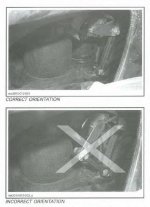Well, if any work was done back there recently- rear tire change, etc, let's check that the sensor linkage has been reconnected properly. Should look like this:
View attachment 149895
The sensor arm points to the rear. And it won't hurt anything to spray a little WD or CRC on the two bolts to lube that connection.
We can do a test right there in the garage. Let's try to adapt the procedure from the repair manual to a DIY at home procedure. I'm assuming you have an SE5 or SE6.
Place something on both sides of a front wheel to act as a wheel chock so that the machine won't roll....just to be extra safe....and open the garage door. Sit on the machine and start the engine. Release the parking brake and put it in first gear. Take your foot off the foot brake. Adjust your suspension to the lowest setting on the display. Check that the suspension adjusts air as necessary and stays stable. Raise the settings one setting at a time to check that the compressor runs and the system stops at the next setting and remains steady. Do that all the way to the top setting, then reverse that process and lower the settings to the lowest setting. Take your time and pause between settings. You'll see the headlight beam changing on the wall, hear the compressor and vent valve, and feel the frame movement. If at any setting the system sits there and cycles between venting and running the compressor all on its own, then that's a problem and take it in. Probably a sensor issue.
Set the setting to the middle position and allow the system to stabilize, then get off the bike. Remember that the wheels are chocked so she's not going to move. When you take your weight off the bike, the frame will rise. The vent valve will open and vent the air. Once the system stabilizes, get back on - the frame will lower - and check the the compressor runs to puts the frame back to the set position.
And if you really want to get specific, get your lovely assistant for some help. With you sitting on the bike, adjust the suspension to the lowest setting and measure from the rear screw on the footrest support plate to the floor. That's the screw just aft of the passenger foot rest on the side metal plate. Should be around 13 inches. Now adjust the suspension to the highest setting. When the system stabilizes, take another measurement. Should be around 15 inches. Now, those exact numbers are going to be a little different depending on your weight in the seat, rear tire pressure, etc. But bottom line, the total frame height change should be ABOUT 2 inches - plus or minus. If you're getting much less than that, the system is too sensitive to changes and will overreact. Have your dealer do the ACS position sensor reset in BUDS.
If you discover a sensor issue that requires it to be replaced, also ensure your dealer does the sensor reset procedure.
If everything checks out and the system acts stable and doesn't cycle for no apparent reason, then the cycling you're getting on the road is probably the normal response to frame position changes as you're riding - such as braking, bouncy roads, you or your passenger shifting your weight around, etc. As I mentioned, you may just be noticing it more.

